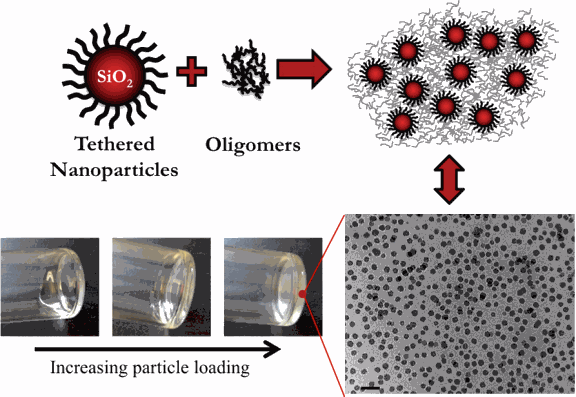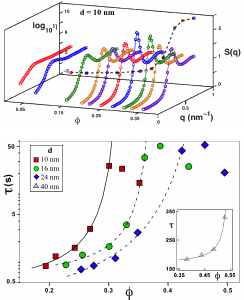The unusual properties of water, including its anomalous thermal expansion and density anomaly, have intrigued researchers for decades. These properties are notoriously hard to investigate experimentally owing to the inherently small length scales and complex interactions that appear to govern the physics of these materials. Studies of small particles (colloids) dispersed in solvents, known as colloidal suspensions, used as models for atomic and molecular liquids have shown that some of these anomalies can be engineered in colloidal suspensions of soft particles. A report published in Physical Review Letters describes research carried out at the U.S. Department of Energy Office of Science’s Advanced Photon Source (APS) at Argonne National Laboratory that elucidates the arrangements and mobility of soft nanoparticles in dense suspensions that mirror the anomalies observed in complex liquids like water. This discovery, which is the first instance of experimental observation of such behavior in a colloidal suspension, allows for an extension of the toolbox of the experimental physicist interested in employing suspensions to mimic molecular liquids, with the added advantage of readily accessible length and time scales.
The research team, with members from Cornell University and Argonne, synthesized soft nanoparticles by densely tethering small polymers onto the surface of silica nanoparticles. Small-angle x-ray scattering (SAXS) and x-ray photon correlation spectroscopy (XPCS) measurements were carried out at X-ray Science Division beamlines 12-ID-B and 8-ID-I at the APS to reveal the equilibrium structure and the characteristics of particle motion, respectively.
It was found that the particle arrangements become more disordered and move faster when more particles are added into the suspension beyond a critical particle volume fraction, coinciding with a sharp increase in the resistance by the system of grafted nanoparticles to physical deformations.
“It becomes easier for any particle in these suspensions to diffuse when they are more surrounded by their neighbors; the counterintuitive nature of this situation can be illustrated with the following analogy - it is easier to make a run and score a touch down when the opposing team has fifteen people in defense,” said Samanvaya Srivastava, a senior graduate student at Cornell University and lead author of the Physical Review Letters article.This is in contrast to the usual situation where increasing the concentration of particles in a dilute suspension decreases the space available for placing new particles, thus increasing particle ordering and slowing them down.
The anomalous behavior of particles suspended in water and other complex liquids has been long argued to exist for systems with soft repulsion, which is characterized by a potential energy that exhibits a finite width over which particle interaction occurs. These empirical findings lend support to an emerging consensus from simulations and provide for a model system for studying systems with soft repulsive interactions.
See: Samanvaya Srivastava1, Lynden A. Archer1* and Suresh Narayanan2, “Structure and Transport Anomalies in Soft Colloids”, Phys. Rev. Lett. 110, 148302 (2013). DOI: 10.1103/PhysRevLett.110.148302
Author affiliations: 1Cornell University, 2Argonne National Laboratory
Correspondence: *laa25@cornell.edu
This work was supported by the National Science Foundation, Award No. DMR-1006323 and by Award No. KUS-C1018-02, made by King Abdullah University of Science and Technology (KAUST).
Use of the Advanced Photon Source at Argonne National Laboratory was supported by the U.S. Department of Energy Office of Science under contract DE-AC02-06CH11357.
The Advanced Photon Source at Argonne National Laboratory is one of five national synchrotron radiation light sources supported by the U.S. Department of Energy’s Office of Science to carry out applied and basic research to understand, predict, and ultimately control matter and energy at the electronic, atomic, and molecular levels, provide the foundations for new energy technologies, and support DOE missions in energy, environment, and national security. To learn more about the Office of Science x-ray user facilities, visit http://science.energy.gov/user-facilities/basic-energy-sciences/.
Argonne National Laboratory seeks solutions to pressing national problems in science and technology. The nation's first national laboratory, Argonne conducts leading-edge basic and applied scientific research in virtually every scientific discipline. Argonne researchers work closely with researchers from hundreds of companies, universities, and federal, state and municipal agencies to help them solve their specific problems, advance America's scientific leadership and prepare the nation for a better future. With employees from more than 60 nations, Argonne is managed by UChicago Argonne, LLC for the U.S. Department of Energy's Office of Science.


